The “do-it-yourself” tag gets tossed around a lot in horse-training circles. “She’s a successful DIY all-around exhibitor…but her horse goes to the trainer’s for six months a year” seems more often to be the case. But Danny Blackburn, a reiner from Selma, North Carolina, takes the DIY tag to its most basic level. He’s bred, trained, and even shod his own mounts since he first entered the reining pen in 1998.
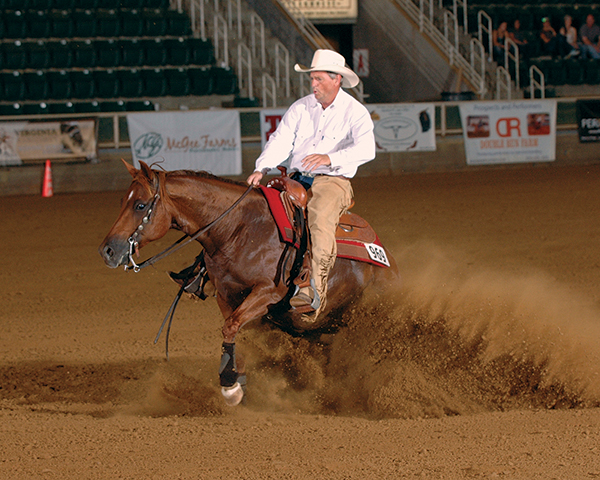
Along the 63-year-old horseman’s journey to become the president of his Southeast Reining Horse Association and find himself “in the money” on a regular basis at reining events, Blackburn has experienced the highs of success and the lows of hard-knocks lessons. He’s built on those experiences to become a truly successful DIY reiner. Keep reading to learn from Blackburn’s experiences.
The Road to Reining
Blackburn rode as a kid but left it all behind—as many of us do—when he headed off for college and a career as a civil engineer. In 1992, his children convinced him to buy them a pony. He obliged, and also bought himself a 2-year-old project horse. He enjoyed training his trail horse and eventually started other prospects.
Blackburn and his son decided to try team penning. At a penning one evening, they saw neighbor and non-pro reiner Philip Joyner spinning his mare Smokem Miss Solano (“Snort”). Intrigued, they struck up a conversation. Joyner thought the 4-year-old might make a perfect penner because she didn’t seem talented enough for high-level National Reining Horse Association competition. Blackburn made the purchase, and Joyner introduced him to reining maneuvers. “I knew nothing about leads,” Blackburn recalls. “I’d never experienced a spin or a sliding stop. There were buttons that I had never imagined.”
Blackburn’s stint as a team-penner was short, but he found he enjoyed practicing Snort’s reining maneuvers, learning from his mare along the way. Several months later, Joyner set out for the North Carolina State Fair reining classes and asked Blackburn if he wanted to come along. Up for anything, Blackburn loaded up his mare and headed to his very first horse show. “The first reining class I saw was the one I participated in,” he shares. “I did well, but if I’d known more about leads and lead departures, I’d have done really well.”
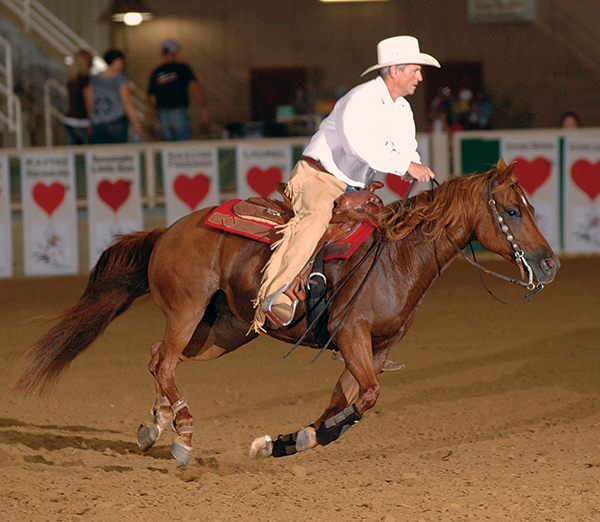
Continuing to work on his own, in true DIY style, Blackburn showed in AQHA and NRHA green reiner and rookie classes. Blackburn was an avid student, learning from his mount. “I was blessed to have a horse that trained me,” he says. “At least one part of the team needs to know what they’re doing. I didn’t have to put a lot of pressure on her in the green and rookie, and slowly, she grew into a much better show horse than anyone thought she’d be.”
Blackburn bought a second horse, Street Smart Genie (“Streetie”). His two horses had much different styles, which meant he learned even more. Snort stopped with her nose pointed out, “like a bird dog,” he explains, and her spin was flat. Streetie had a classic stop, but she held her front end higher in her spins. “Streetie taught me you can’t try to make all horses fit a mold,” Blackburn shares. “You have to let them have their own style. You have to feel what the horse’s body is doing and respond to it.” Blackburn also learned to focus not only on the maneuvers but also to enjoy the horse-human relationship.
“His emphasis on communication sets Danny apart,” says trainer Jesse Chase of Wendell, North Carolina, who has shown Blackburn-trained horses. “He and his horses seem to speak the same language. He’s also extremely patient. I’ve never seen him force a horse to do anything.”
The Non-Pro Pro
Blackburn focuses on developing a prospect that willingly accepts instruction. “I train my horses to look to me for guidance,” he says. “Whether you’re dealing with horses or people, it’s all about providing choices and setting the stage to help the individual to make the best choice.”
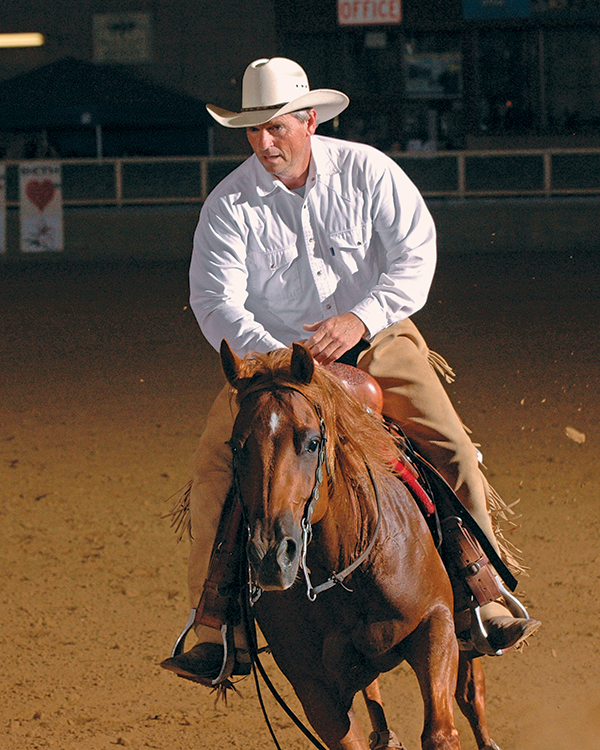
“Danny really puts the time in,” Chase says. “He knows his horses exceptionally well, and he develops excellent timing and feel with each of them.”
Blackburn’s young-horse goals center on regional 3-year-old futurities. During the 2- and 3-year-old years, his horses work three to four times a week. He rides the 4- and 5-year-olds less often, taking them to small AQHA shows to gain mileage in a relaxed setting. Older finished horses stay out in the field between shows. “My show horses know what to do. They’re in good physical shape from living in the pasture and never act sore after a show.”
This might all seem as if it came easily to Blackburn, but it took a while to build his plan for success. In his first attempt at training, he admits, “I thought too much about Snort and her ‘bird dog’ stop. The judges didn’t like that, so I thought I could train my next filly to stop with her head tucked. I didn’t pay enough attention to what was comfortable for her. My emphasis on head position inhibited the stop. She never ran as freely as she should have.”
Learning His Limits
In the early 2000s, Blackburn acquired a stallion named Lucky Bay Lena (“Lucky”) and began breeding his own prospects. The horse had been successful in open and non-pro classes. He was capable of marking excellent scores—75s—and quickly showed Blackburn how much he still needed to learn as a trainer and showman. “I didn’t know how to control the speed to his stops,” Blackburn admits. “He could out-spin me. I didn’t show him much—I didn’t want to make him look bad. But I rode him at home, and he’d tune me up. I’d spin or stop him and realize that I needed to do a better job on my other horses.”
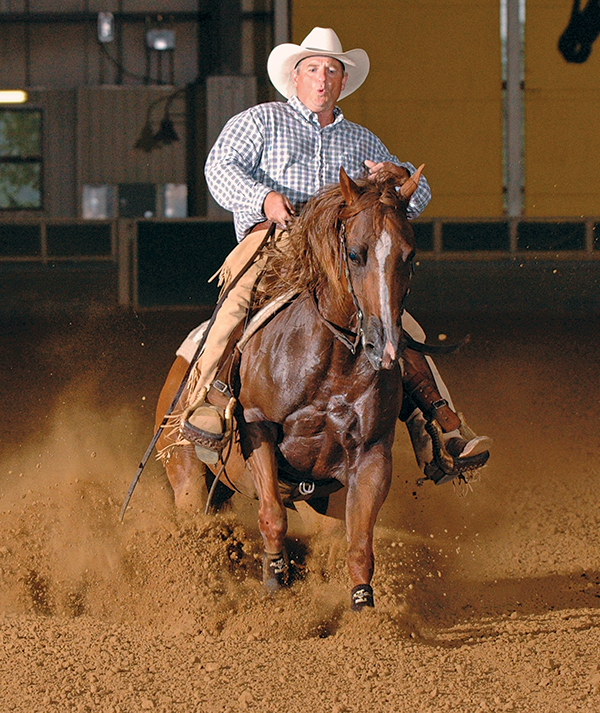
“Lucky is a very talented horse,” Chase adds. “His offspring have remarkable consistency, physically and mentally. His get are so much alike that I sometimes think Danny gets to train and show the same horse over and over. That Danny lets them mature on their own time frame only contributes to their success.”
In 2004, Blackburn showed homebred Lucky Lena Lady to the limited non-pro championship at the Southeast Reining Horse Association Futurity. “She always wanted to go slow, so when we ran fast and my body position even suggested a slowdown, she’d come back immediately,” he recalls.
“This gave me the confidence to run hard and be less cautious.” He repeated the win in 2005 with another homebred, Second Chance Lucky.
But in 2006, he had a rude awakening about how much he still had to learn—and the downside of doing it all yourself. “I didn’t understand that lead departures and lead changes start from the horse’s hind feet,” he laments. He’d been making lope departures and lead changes by pushing his outside leg against the horse’s shoulder. Although the cue worked most of the time, it finally cost him dearly. That year, he had a shot at top placings at the Dixie Futurity with Smokem Lucky Dobber (the horse he still refers to as “the best horse I’ve bred, trained, and shown.”) He did too much positioning in the lope-off and inadvertently angled the horse in the wrong direction because of the shoulder cue (rather than bending him in the direction in which he needed to go and using his outside leg farther back). Dobber struck off on the wrong lead. Although Blackburn made a quick fix, the damage was done: They dropped from a win to third place, and Blackburn, always learning, adjusted his program.
Blackburn started showing his current NRHA competitors, Smokem Lucky Solano (“Lucky”) and Lucky Hollywood Lady (“Lady”), in NRHA as 6-year-olds in 2010. In 2012 and 2013, Lucky finished in the top 10 in NRHA novice horse non-pro level 1. In 2013, they were the limited non-pro champions in the Southeast Regional Affiliate Finals and went on to top-10 and top-five finishes in the affiliate finals in Oklahoma. In 2015, Lady won the Southeast Regional Affiliate Finals in novice non-pro level 1 and was reserve in level 2. At 11 years old apiece, they’re still going strong in the show pen.
“They know their jobs and are happy doing it,” Blackburn says. “They meet the definition of being ‘willingly guided,’ which is the cornerstone of NRHA. They accept what I want them to do.”
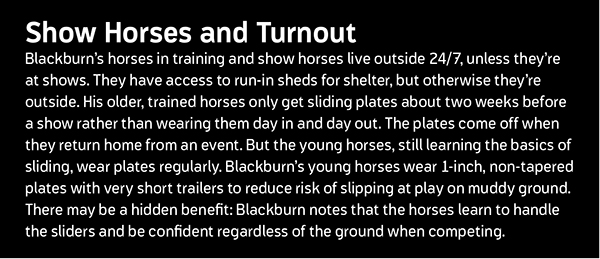
And DIY doesn’t get better than that.






